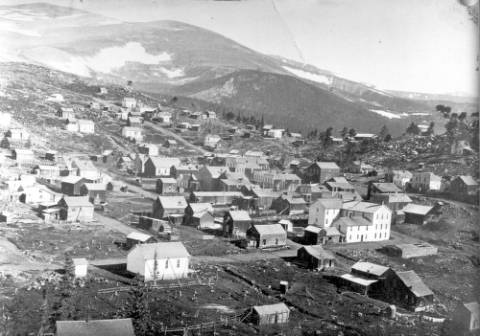
Caribou, Colorado in 1870s
All that remains are a few stone walls. Nature has reclaimed the rest of what was once a vibrant mining town located high in the mountains near the Continental Divide. Now the Columbine flowers bloom, and the green grasses blow in the winds. Marmots scurry among the boulders that dot the landscape here and there.
But travel back in time 140 years ago, and a completely scene would greet you. If any time is synonymous with Colorado’s boom times during its famous gold rush of the 1800s, Caribou is it. Ironically, though Caribou’s good times were not based on gold strikes, but silver.
The gold strikes of 1859 brought prospectors from far and wide streaming into Colorado. Though some found gold in places like Black Hawk and Central City, more did not. One prospector, Sam Conger, spent some time in the mountains looking for gold and came up empty, or so he thought. He’d seen something, but didn’t take it for anything of value.
It was only when he returned several years later with a friend, William Martin, who had mined silver in Nevada, that they realized exactly what Conger had seen. A small island of silver located at 10,000 feet, rich lodes of silver had been struck.
Thought they tried to keep the word quiet, it wasn’t long before others heard of this signficiant silver strike. In fact, even the famous New York Times got in on the publicity, describing it as:
“Wild excitement among the adventurers of the territory. The richest silver deposits on the continent.”
As prospectors and miners moved in, wagon roads were built, and soon a town sprouted up in this most likely of places — a rugged and harsh environment, where the winds blew over 100 miles per hour and snow piled up by the feet in the winter.
Despite the conditions, the town grew quickly and it wasn’t long before it was a bustling community with 3000 people, 60 businesses, a schoolhouse, and even a fancy hotel — the Sherman House. You had to be a little hearty to survive those winters, and people kept up their spirits by hosting dances, events, and even balls during Christmas and New Year’s. The Caribou Post touted the New Year’s Ball of 1872 as:
“ a high and happy affair, none but those of the highest standing were admitted. It was probably the most elevated ball given in honor of the New Year in America.”
But like most mining towns, the boom times of Caribou would eventually come to an end after a 12-year run of silver mining that yielded around $8 million dollars in revenue. Eventually, the government subsidy of silver stopped, the prices dropped, and it became too costly to continue mining.
The town suffered through two major fires, and most of the buildings from its famous mining heydays were destroyed. Today, a drive up the old Caribou Road reminds me what once was, and the beauty of Caribou’s wildness that has reclaimed reminds of the good that still remains.

